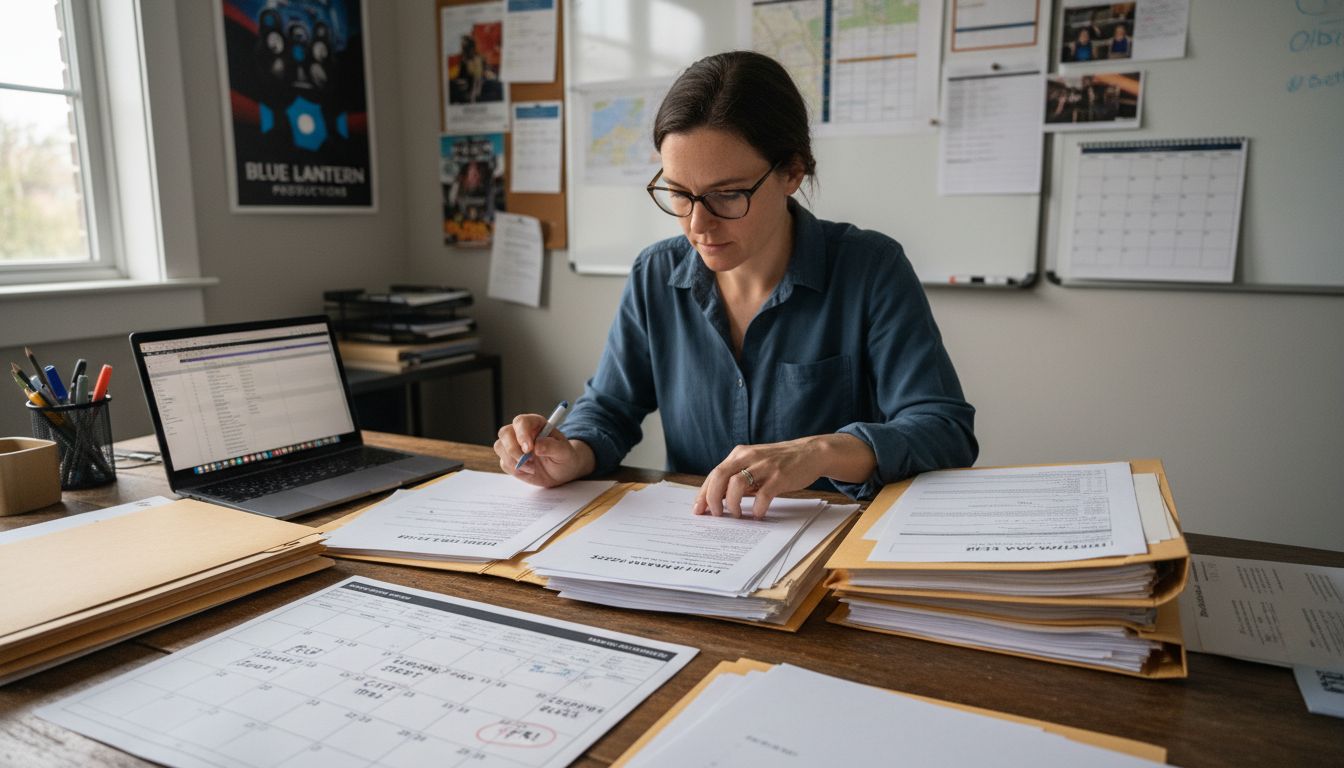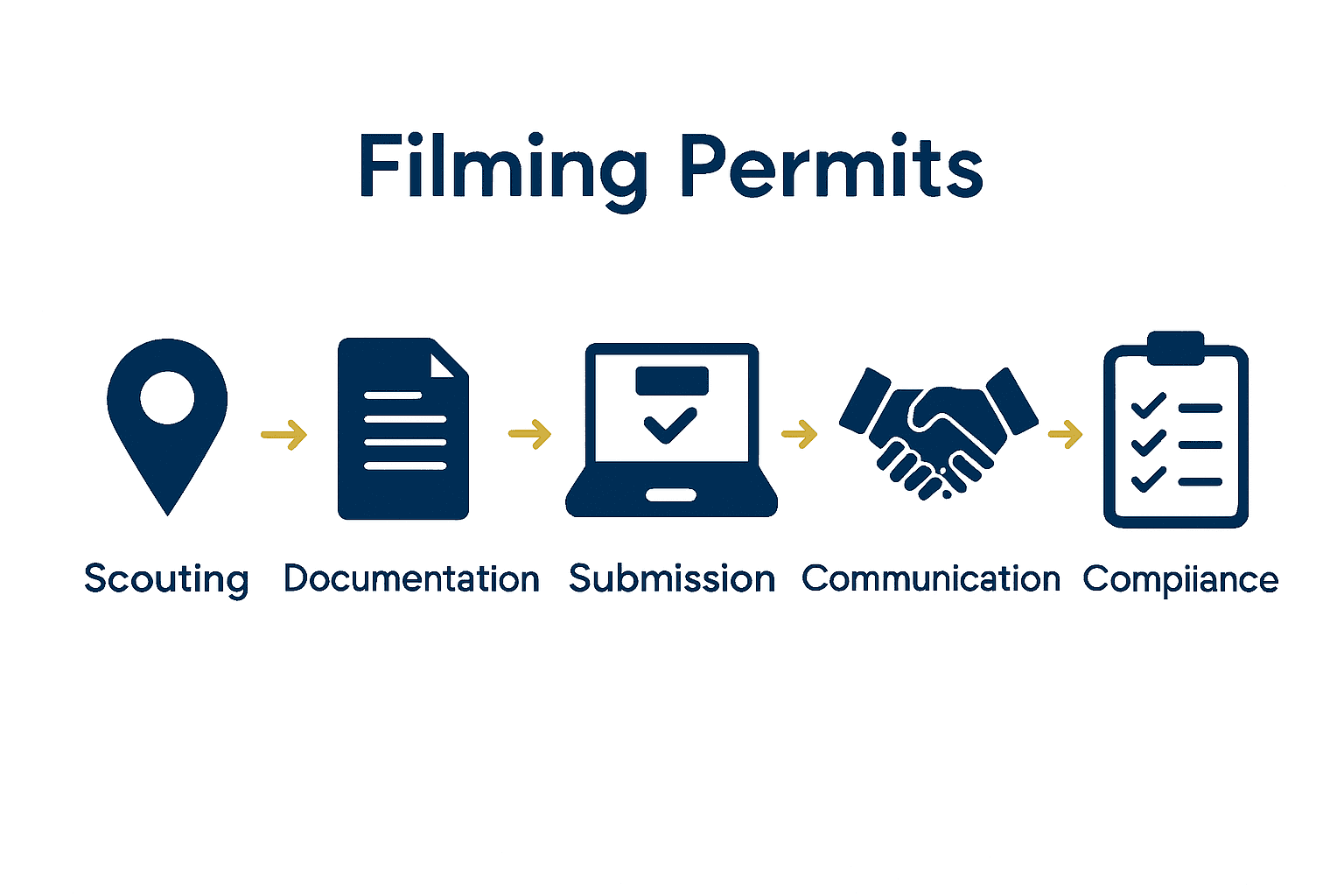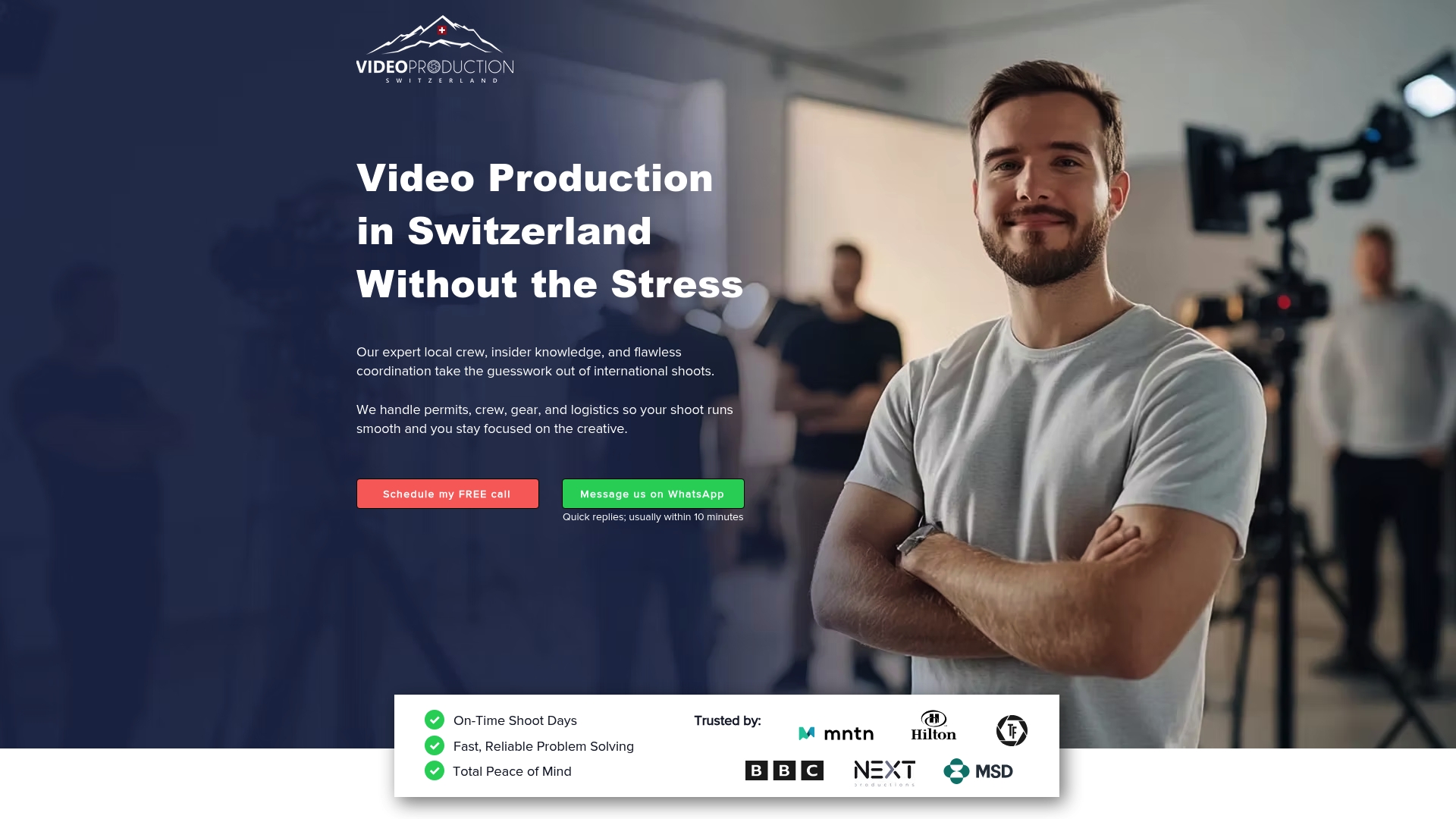How to Get Filming Permits: A Step-by-Step Guide for Crews
- info1419758
- Oct 31
- 8 min read

Film productions can face serious delays if permits are not properly secured, with some projects losing thousands each day due to missteps. Understanding the film permit process helps you turn creative ideas into scenes with fewer legal or logistical obstacles. By following the right steps, you make sure your filming locations, paperwork, and approvals come together smoothly for a hassle-free shoot.
Table of Contents
Quick Summary
Key Point | Explanation |
1. Assess potential filming locations carefully | Evaluate locations that suit your project’s vision and consider accessibility, logistics, and environmental factors during the scouting process. |
2. Compile comprehensive documentation for permits | Gather all required documents like shooting schedules, shot lists, and insurance certificates to support your filming permit application. |
3. Monitor the permit submission process closely | Submit applications through proper channels, respond promptly to requests, and be aware of processing timelines to avoid delays. |
4. Engage with local stakeholders early | Establish good relationships with local authorities and property owners by sharing your project details and addressing their concerns proactively. |
5. Verify compliance with filming regulations | Ensure all permit requirements and insurance obligations are met before filming to avoid legal complications and ensure a smooth production. |
Step 1: Assess Filming Requirements and Locations
This step involves identifying and evaluating potential shooting locations that align with your project’s creative vision and logistical needs. Location scouting transforms your script from paper to potential reality by finding the perfect visual backdrop.
According to Wikipedia, location scouting begins after scriptwriters, producers, or directors determine the type of scenery required for scenes outside the studio. Your goal is to find locations that match your narrative while being practical and achievable.
Start by creating a comprehensive location breakdown from your script. List every scene requiring an exterior or unique setting. Consider these critical aspects:
Scene requirements and specific visual characteristics
Potential environmental challenges
Lighting conditions throughout the day
Accessibility for crew and equipment
Noise levels and potential sound interference
Proximity to support infrastructure
As Visionaery Pro recommends, perform a hands-on site visit to verify practical requirements. During your location assessment, check for convenient loading areas, parking proximity, and crew accessibility. Pay special attention to how your equipment and team can effectively operate within the space.
Pro Tip: Always take extensive photographs and create a digital location portfolio to compare and reference potential shooting sites.
Once you have identified and preliminarily assessed potential locations, you will be ready to move forward with detailed permit research and location permissions. Your next step involves understanding the specific regulatory requirements for each potential shooting site.
Step 2: Gather Essential Documentation and Details
In this critical step, you will compile all the necessary paperwork and details required to support your filming permit application. Think of this stage as building a comprehensive portfolio that demonstrates your production’s professionalism and preparedness.
According to Filming Portal UAE, successful permit applications require several key documentation components. Your goal is to create a thorough and organized packet that addresses every potential administrative requirement.
Here are the essential documents you will need to gather:
Detailed shooting schedule with precise timelines
Comprehensive shot list breaking down each scene
Complete equipment inventory with specific details
Comprehensive crew and cast information
Passport copies for all international team members
Proof of insurance certificates
From Filming Portal UAE, additional critical documents include:
Commissioning letters
Full screenplay or script
Detailed storyboards
Precise location descriptions
Security deposit documentation (if applicable)
Pro Tip: Create digital and physical copies of all documents. Organize them in a clear folder system with both printed and electronic versions for maximum flexibility.
Carefully review each document to ensure accuracy and completeness.

Missing or incorrect information can significantly delay your permit approval process. Your meticulous preparation now will streamline subsequent steps in acquiring filming permissions.
With your documentation assembled, you will be ready to submit your comprehensive permit application and move forward in your production journey.
Step 3: Submit Permit Applications to Authorities
In this crucial stage, you will officially submit your meticulously prepared documentation to local film authorities and navigate the permit approval process. Your goal is to transform your carefully compiled paperwork into an approved filming permit.
According to Filming Portal UAE, the submission process typically involves several key steps. You will need to submit your application through the designated official portal, pay initial processing fees, and be prepared for potential additional documentation requests.
The typical submission workflow includes:
Complete the official online application form
Upload all required documentation
Pay the initial application fee
Wait for preliminary review
Respond promptly to any additional information requests
Await final approval
Filming Portal UAE highlights important processing timelines you should anticipate:
Standard commercial permits: 5 to 7 working days
Feature film permits: 10 to 15 working days
Rush processing: 2 to 3 working days (potential additional fees)
Pro Tip: Always budget extra time for unexpected administrative delays and have contingency plans for your production schedule.
As referenced in Egy Docs, be prepared for potential security clearance reviews. Some authorities may require additional verification of your crew and project details.
Remain patient and professional throughout the process. Prompt communication and thorough documentation will significantly improve your chances of smooth permit approval.
Your preparation demonstrates your production’s reliability and commitment to following local regulations.
Once your permit is approved, you will be ready to move forward with the final preparations for your film shoot.
Step 4: Communicate with Relevant Local Stakeholders
This critical stage involves building relationships and establishing clear communication channels with local authorities, property owners, and community representatives who will be impacted by your film production. Your goal is to create transparency and gain supportive cooperation from all key stakeholders.
According to Creative Wales, engaging with location managers is an essential first step. These professionals often work freelance and may be unfamiliar with the specific area. You will need to discuss your project comprehensively, sharing detailed information about how locations will be used.
Key communication objectives include:
Explain the nature and scope of your film project
Share relevant script sections
Determine precise filming timelines
Identify specific interior and exterior shooting requirements
Establish clear boundaries and access protocols
Factual America emphasizes the importance of consulting local authorities early in the process. They can provide critical insights about:
Specific permit requirements
Associated filming fees
Location restrictions
Potential time limitations
Drone usage regulations
Pro Tip: Create a detailed briefing document that outlines your production schedule, crew size, equipment requirements, and potential community impact.
Be prepared to address potential concerns proactively. Local stakeholders will appreciate your transparency and professionalism. Listen carefully to their feedback and be willing to make reasonable accommodations that demonstrate respect for the community.
Successful communication builds trust and can significantly smooth your path to obtaining necessary permissions and support for your film production. Your diplomatic approach now can prevent potential complications later in the filming process.
Step 5: Verify Permit Approval and Compliance
This critical stage involves thoroughly confirming that your film production meets all legal requirements and has secured proper authorization. Your objective is to ensure complete compliance and minimize potential operational risks before your shoot begins.
According to City of Sydney, filmmakers must be prepared to demonstrate they have satisfied all necessary licensing and permit requirements. This involves conducting comprehensive hazard and risk assessments for all proposed filming locations.
Key verification steps include:
Review all permit documentation
Confirm insurance coverage requirements
Validate location specific restrictions
Check public liability insurance levels
Ensure all necessary signatures are in place
Spiel Creative emphasizes the critical importance of maintaining proper documentation. You should:
Keep digital and physical permit copies on site
Understand usage rights for each location
Verify specific local filming restrictions
Confirm liability terms with property owners
Prepare documentation to prove filming authorization
Pro Tip: Consider hiring a local location manager or legal consultant to help navigate complex permit requirements and ensure full compliance.
Public liability insurance is particularly crucial. City of Sydney recommends preparing for $20 million in coverage, with potential adjustments based on project complexity and risk levels.
Taking these verification steps seriously demonstrates your professionalism and commitment to responsible filmmaking.

Your thorough approach will help prevent potential legal complications and ensure a smooth production experience.
Here’s a summary of each key step in the film permit process:
Step | Main Objective | Essential Actions | Key Documents or Requirements |
Assess Locations | Align visuals with script Evaluate logistics | Script breakdown Site visits Photo documentation | Location list Photos Location portfolio |
Gather Documentation | Build permit packet | Collect production details Organize digital records | Shot list Schedule Insurance Passports Screenplay |
Submit Applications | Obtain authority approval | Upload documents Pay fees Respond to requests | Application form Proof of payment |
Communicate with Stakeholders | Gain community cooperation | Stakeholder meetings Briefings Share plans | Briefing document Contact log |
Verify Compliance | Ensure legal authorization | Review permits Check insurance Confirm signatures | Permits Insurance certificate Risk assessment |
Simplify Your Filming Permit Process with Local Experts
Securing filming permits can feel overwhelming with all the detailed documentation, communication with local authorities, and strict compliance requirements involved. If you worry about navigating complex permit submissions or managing stakeholder expectations, you are not alone. The pain points of organizing schedules, insurance, and site coordination often make location scouting and permit approvals seem daunting.
Imagine having a trusted local partner who handles these challenges for you. At Video Production Switzerland, we specialize in streamlining the entire process from scouting ideal locations that fit your script to securing all necessary permits efficiently. Our expert local crew and logistical management ensure your project runs smoothly without permit delays or last-minute surprises. With over 20 years of experience, we understand the detailed steps highlighted in guides like this one and transform them into seamless action.

Ready to move past the hassle and focus on your creative vision? Visit Video Production Switzerland today for your free consultation. Learn how our end-to-end permit facilitation, equipment sourcing, and local coordination can keep your film project on time and stress-free. Don’t let paperwork slow your shoot down. Take the first step toward flawless filming logistics now.
Frequently Asked Questions
What are the first steps in getting a filming permit?
Start by assessing your filming requirements and scouting potential locations that fit your project’s vision. Create a detailed list of scenes needing specific settings and consider practical aspects like accessibility and environmental challenges.
What documents do I need to gather for my filming permit application?
You will need essential documents such as a detailed shooting schedule, equipment inventory, crew information, and proof of insurance. Organize these documents systematically, both digitally and physically, to streamline your application process.
How long does the permit approval process usually take?
The typical processing time for filming permits can range from 5 to 15 working days, depending on the type of project. Budget extra time for possible delays or additional requests from the authorities to avoid disrupting your production schedule.
How can I effectively communicate with local stakeholders about my film project?
Engage with local authorities and property owners by providing clear information about your project, including filming timelines and any specific requirements. Prepare a briefing document to address their concerns and ensure everyone is on the same page.
What should I do to ensure compliance with filming permits before I start shooting?
Verify that you have all necessary permits, insurance coverage, and any specific local restrictions in place. Conduct a thorough review and keep copies of all documentation on site, which can help mitigate legal risks during production.
How can I create a comprehensive location portfolio for my filming sites?
Take extensive photographs during location scouting and compile them into a digital portfolio. Include notes on each location’s specific characteristics and environmental conditions to aid in decision-making later in the process.
Recommended

Comments